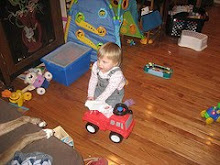Listening to NPR the other day I heard this story about "Allowance Economics: Candy, Taxes & Potty Training." I thought it was pretty interesting and that there was some fun math involved. In college I took at class on Law and Economics and I recall that there is a lot of thought that goes into how penalties are set (disincentives), for example speeding tickets. If you set them too low, people won't mind paying them and they will not work as a disincentive. If you set them high enough they should work well for the majority of people. There are also associated costs for enforcement, and people speed or don't speed based on some combination of the disincentive associated with the potential cost of being caught speeding and the likelihood of being caught. I know, from past experience, that when driving from PA to MA, I used to be particularly careful in CT because legend had it that their tickets where very expensive and their enforcement was good.
In this story, the parent is willing to pay for "essential" items, while the kids will use their allowance for "non-essentials." In addition, the parents levied a tax on "non-essentials" that were also bad for them, like candy. I was thinking it would be fun to play with various tax rates and models in which students would or would not be willing to buy certain items depending on the tax rate. Would they still by candy if the tax to their parents was 10% vs. 100%.
Subscribe to:
Post Comments (Atom)

No comments:
Post a Comment